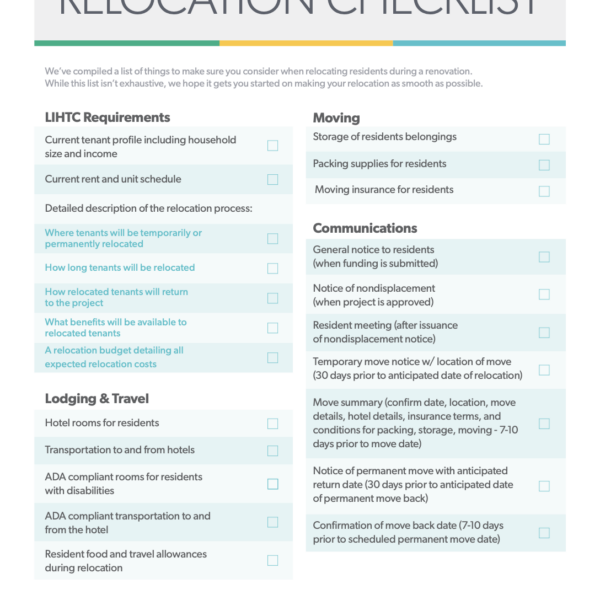
When rehabilitating or making improvements to an existing affordable housing property, the relocation of residents is often a major step of that process so that their individual apartments can be upgraded. If using low income housing tax credits (LIHTC) to support this types of project, you can know that the department of Housing and Urban Development (HUD), the department that oversees low income housing projects across the country, takes this relocation very seriously and will want to ensure that the property’s existing tenants are treated with care and respect. Therefore, HUD has implemented a series of requirements that affordable housing providers must follow during the process of relocation.
At ELC, we have successfully relocated over 700 households as a part of redevelopment efforts at many of our communities, and we learned a lot along the way.
Here are some of the steps we followed and lessons we took away.
When undergoing a project that requires the relocation of residents, there are requirements to consider when applying for LIHTC. These include:
These requirements are in place to make sure that providers are being held accountable to keeping residents’ best interests in mind and having a smooth plan in place. However, they don’t end at keeping track of these specific items regarding the relocation process.

To confirm you’re following LIHTC requirements and other considerations we’ve learned are important, download our free relocation guide.
The relocation process has been one of collaboration, cooperation and communication from the very beginning. Our department directors understood the renovation goals and objectives and led with a spirit of service as they began to lead onsite teams to successfully manage upgrades to each apartment and community.
While we wish we could have kept residents on site, the nature of the project determined that it was safer and better for residents to move off site for a shorter stay. By moving them offsite, we were able to ensure their safety and ultimately complete their apartment renovations faster, getting them back to normalcy quicker.
All residents were given the option to temporarily relocate to one of nine Extended Stay America hotels while the renovations were completed. The anticipated timeframe of the temporary relocation was 14-17 days. ADA accessible hotel rooms were available for those residents that required them.
All costs and fees associated with the hotel reservations were paid by the project, and no out of pocket costs were required by the residents. All residents were also given the opportunity to temporarily relocate with family or friends while the renovation was completed if they did not want to go to a hotel.
Transportation for each resident that required was provided at no cost to the resident either by Uber for those residents that needed standard transportation, or by Special Needs Chicago for those residents that needed accessible transportation.
We wouldn’t expect our own Grandmas and Grandpas to move themselves, so we certainly wouldn’t expect it from our elderly tenants. A professional moving company was engaged for all projects to professionally pack each apartment and move the contents of each resident’s apartment to a secure storage facility. The moving company returned each resident’s personal property from the storage facility and unpacked their belongings. All costs and fees incurred by the moving company were also paid by the project.
Residents were included in onsite meetings where we shared details for a common understanding of how their belongings would be handled, packed, stored, returned and unpacked during the renovation. Communications also included a Notice of Non-Displacement, a relocation survey and a move summary packet that included move details, hotel details, insurance terms and conditions for tenant packing and storage details.
Communication is important at all levels and, most importantly, to the resident. People feel more secure when they have an understanding of what they can expect. Helping residents feel secure, especially when transitioning to a new environment (even if temporarily), should be a key priority for housing providers undergoing relocation.
In terms of staff communication, we held weekly task force meetings that involved staff at all levels coming together to share department plans in an effort to keep everyone aware of what was happening throughout the entire relocation process. Though there is always room for improvement making sure people are on the same page, we made a genuine effort to keep everybody in the loop, which made a world of difference in terms of team efficiency and resident satisfaction and comfortability.
LIHTC is a federal program created by the United States Congress in 1986 that provides incentives for developers and owners of affordable housing communities. LIHTC encourages the development of rental housing with lower rents, which are allocated to tenants based on their income level.
The LIHTC program works by giving state and local governments the authority to issue tax credits over a 10-year period to qualified low-income housing developments. Developers or property owners who receive these credits can then use them as an offset against their federal taxes owed each year. This incentive has been effective in encouraging private investment into affordable housing projects, as well as maintaining existing units at below market rates for those most in need of assistance.
By providing tax credits to developers and owners, this program helps ensure that more of our most vulnerable neighbors can access quality housing options at prices they can afford.
A LIHTC application typically consists of two parts: the general information section and the project specific section. General information includes details such as the applicant’s name, address, contact information, type of development proposed, estimated cost of construction and other details about the project. This part also requires an explanation of how the project will benefit low-income households in its area or region. Additionally, it requires financial statements showing that sufficient funds are available to complete construction with no need for additional financing sources beyond those already identified in the application process.
The second part of a LIHTC application involves detailed descriptions regarding aspects unique to each individual proposed project such as property boundaries; land use plans; environmental impacts; community support letters from local officials; site plan drawings; architectural designs including interior layouts; and estimates related to labor costs and materials needed for completion of work outlined in plans provided previously.
Want to put these tips into action? Fill out the form to download a free copy of our resident relocation checklist.
Feel free to contact us for any future resident, current resident, or general inquiries.